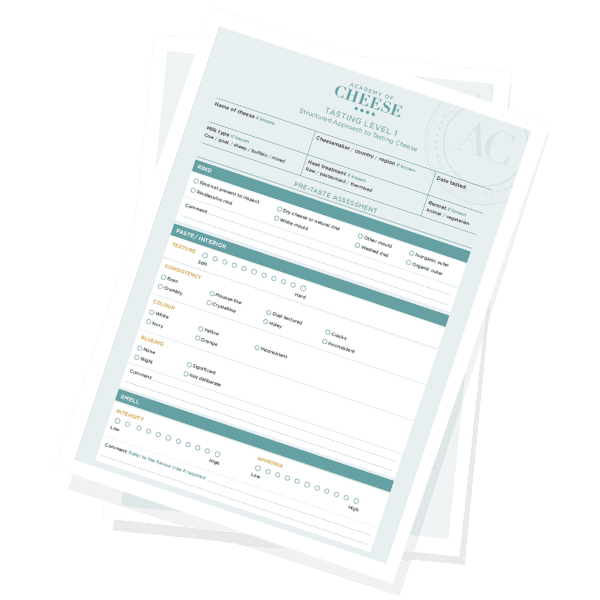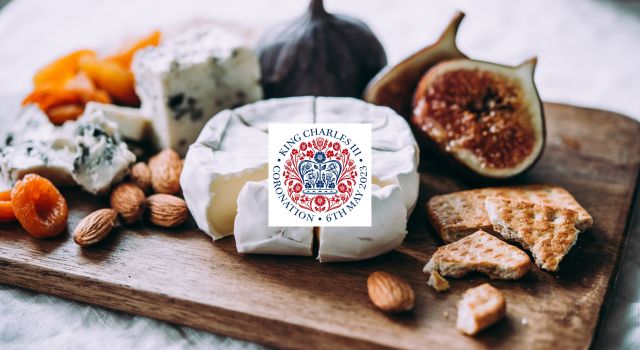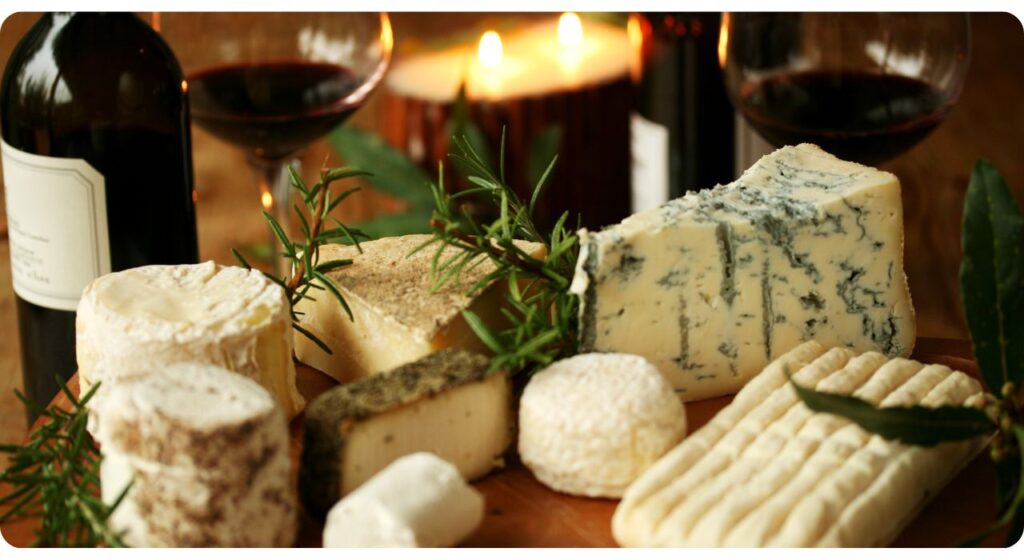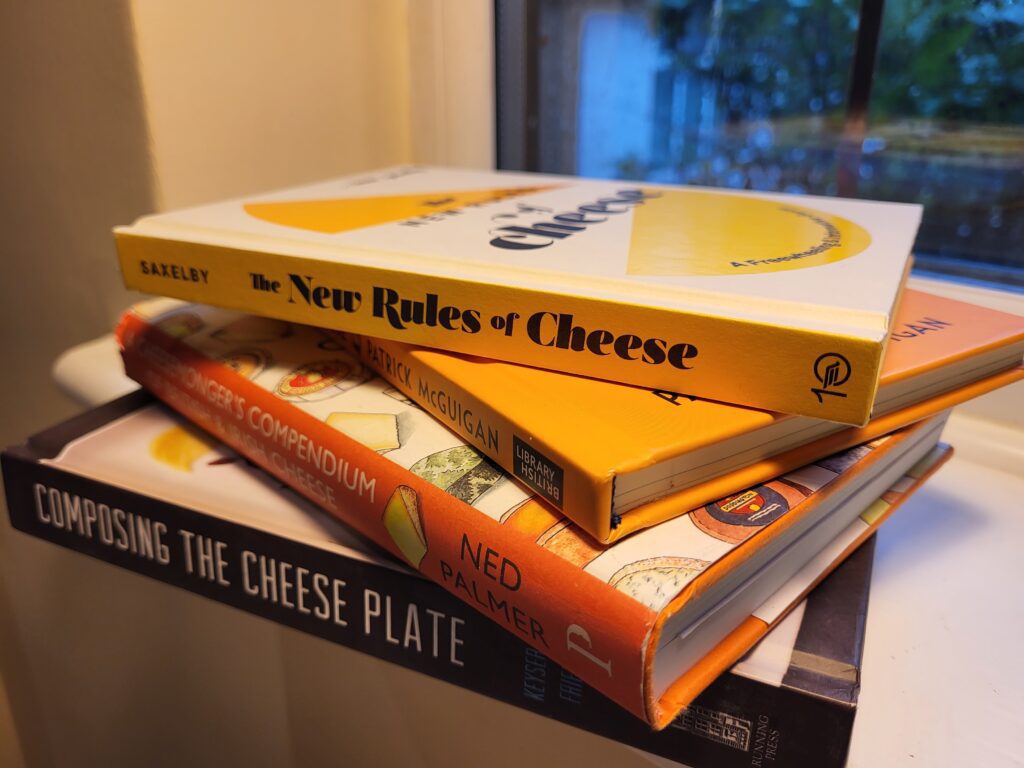OFFICIAL GUIDE
The Ultimate Guide To Tasting Cheese.
The following guide to tasting cheese is based upon the Academy of Cheese’s Structured Approach To Tasting Cheese (SATC) which is used by industry experts to refine their palates and sharpen their ability to recall the cheeses they taste. Don’t worry, even though this method is used by pros, it’s actually quite simple to understand and can help anyone to improve their cheese tasting.
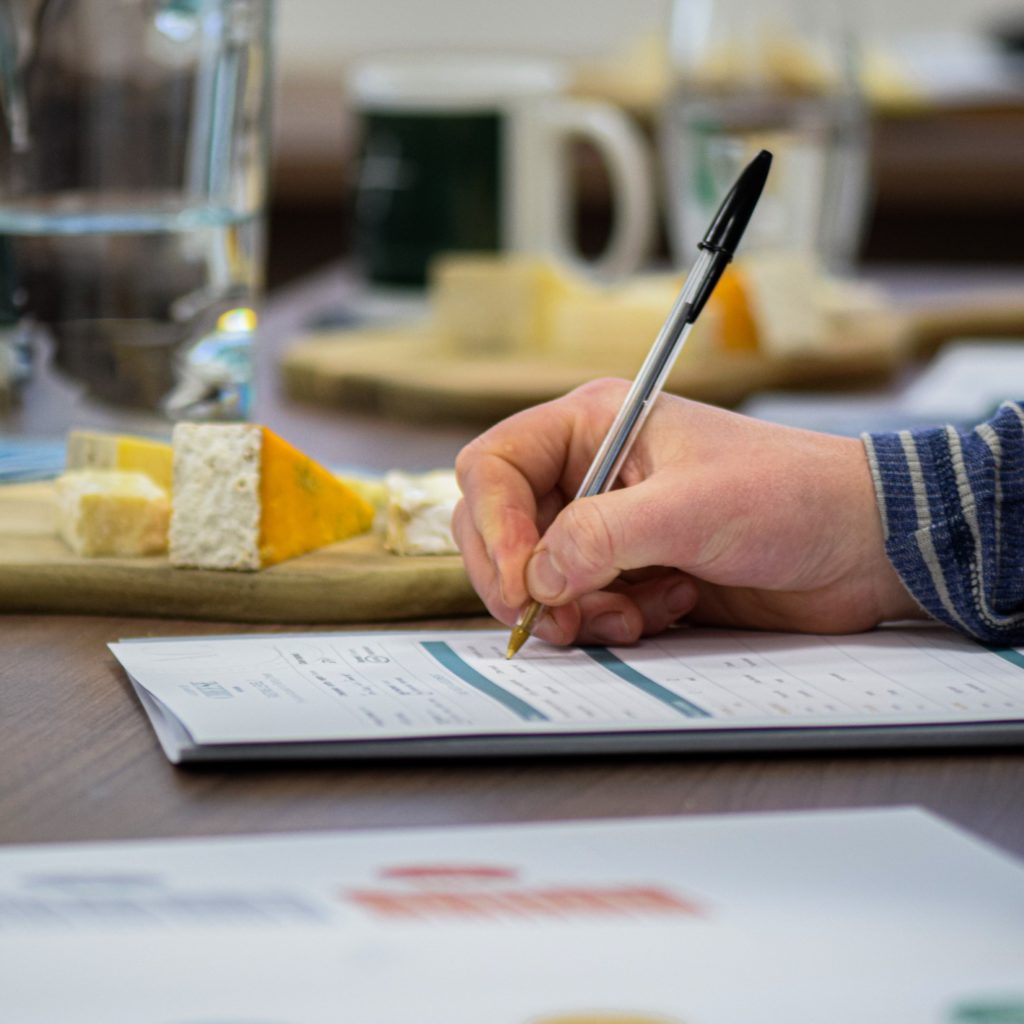
IN THIS GUIDE
Learn how to taste cheese in four stages
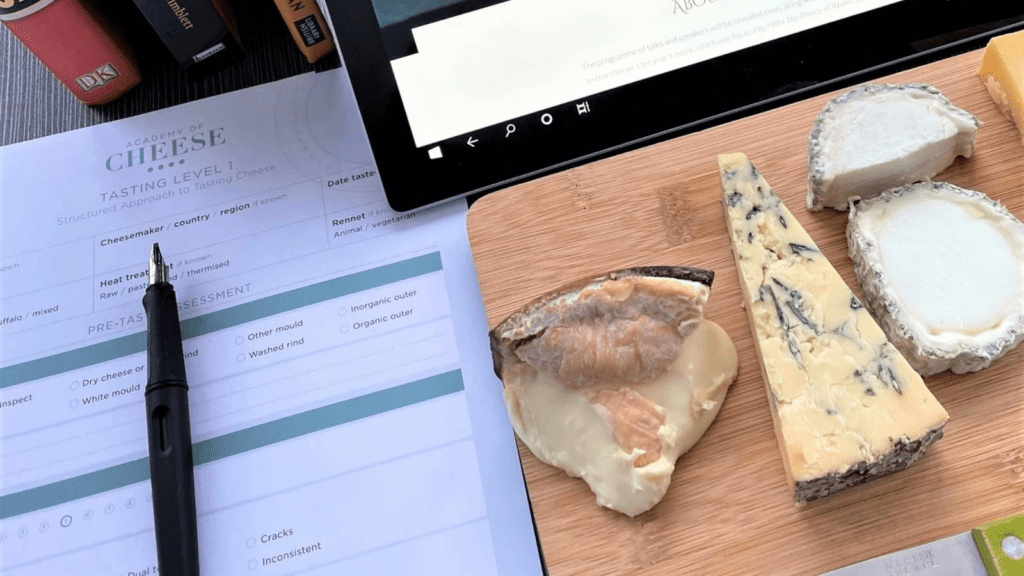
Anyone can taste cheese, all you need is some cheese and your brain. There are four stages to tasting cheese:
Stage 1: Prepare – Make sure you have everything you need
Stage 2: Pre-taste assessment – Touch, inspect and smell
Stage 3: Taste assessment – Identify simple and complex flavours
Stage 4: Conclusion – Complete your profile of the cheese
Chapter 1
How we taste.

Whilst the cheese is in our mouths, humans use two senses – taste (with the mouth) and smell (with the nose). The brain combines these two into a single experience which we call taste. Our personal capacity to taste is called our palate. In this Structured Approach to Tasting Cheese we record the mouth flavours (called “Simple” flavours) and nose flavours (called “Complex” flavours) in different sections.
Mouth flavours
Our mouth evolved millennia ago to provide a fast response to our brain on whether we should or should not eat the food in front of us. Through our mouth we sense 5 flavours, when we were hunter/gathers these flavours enabled us to make instant decisions on whether we should continue eating in the high risk natural environment in which we were living. Although life has evolved a bit and food is very different, the instant response remains. In terms of tasting cheese, we call these mouth flavours the Simple Flavours:
1. Sweet
Sensing sugars such as fructose, sucrose, glucose, lactose, maltose and others, foods with this flavour group were good to eat.
The fast release sources of energy are popular with just about all living things from animals to bacteria.
2. Savoury (sometimes called Umami)
This category was added to the western understanding of taste in the last 30 years, although the Japanese identified it in the first decade of the 20th century. It approximates to fat and protein, which provides slow release sources of energy and is the building blocks of the body. This simple flavour generally tastes good.
3. Salty
Whether tasting table salt or sodium chloride, we are generally receptive to these flavours. This is not surprising since salt is a critical element for the functioning of the body’s muscles and nervous system.
4. Bitter
There are pleasant bitters such as bitter beer or tonic water, but excessive bitterness in food can be unpleasant.
5. Acid
Bacteria commonly produce acids. We can’t taste bacteria, so testing for Acid is the next best thing. Like bitterness, excessive sourness can be undesirable in a food but there are also positive acid/sour flavours such as the tang associated with lemon juice or vinegar.
Chapter 2
The Tasting process
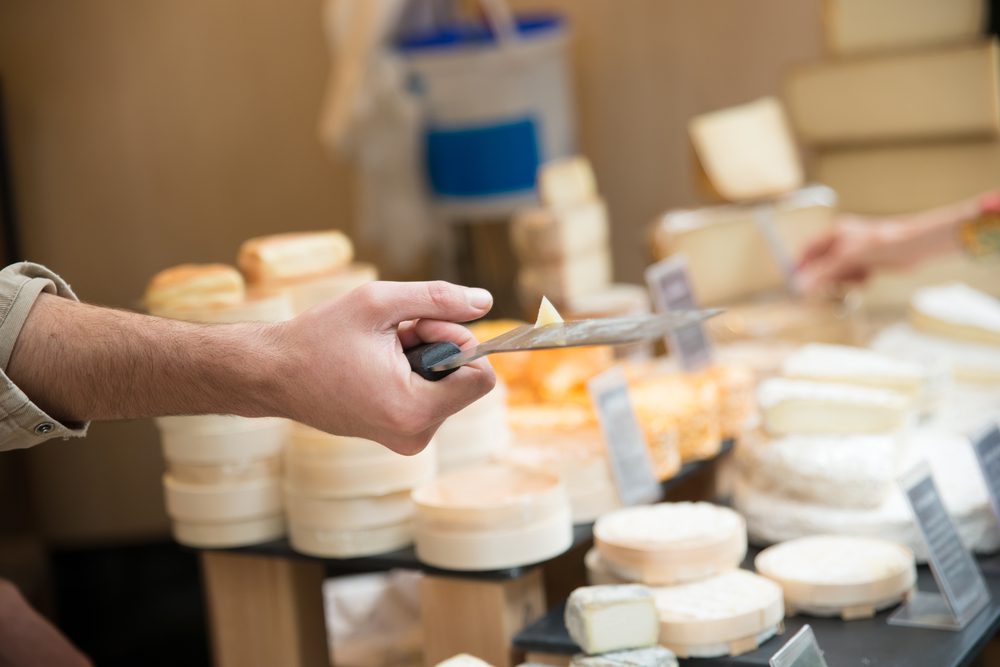
Mastering the art of tasting cheese in a structured way, will not only give you a deeper appreciation of the cheese but also the ability to confidently describe it using a professional vocabulary. In this chapter we explain the four key stages you should go through in the tasting process from the preparation stage through pre-taste assessments to the actual tasting and drawing your conclusions.
Stage 1: Before you start
We know that the temptation to snaffle a delicious piece of cheese as soon as it’s cut is hard to resist. But, you will get much more from the cheese tasting process if you set yourself up for it correctly before you start. Here’s how:
1. Bring the cheese to room temperature.
If you regularly eat good cheese you will be well aware that eating cheese straight out of the fridge is a bad idea, it can be dull & flavourless, dry & crumbly or have a rubbery texture. So, you need to make sure that you to bring cheese to the correct temperature before you start tasting.
2. Have a clean palate.
Consuming strong foods and drinks can affect a your ability to taste by overwhelming the palate, so it’s important when tasting cheese with depth of flavour to use a neutral, low-taste or tasteless palate cleanser, in order to “wipe the slate clean” and assess new flavours in detail.
3. Be prepared to taste.
It sounds obvious, but there is little sense in starting to taste if you then have to break off to find a knife, or something to take notes with. So, make sure that you have your tasting toolkit to hand. This should include:
- A Cheese Tasting Sheet (and pen) to record your notes
- Clean knives and plates
- Neutral biscuits, apples or water to cleanse your palate.
There is a well know saying ‘people buy with their eyes’, if it looks great you are more likely to buy it – with cheese you might smell it first! The Pre-taste assessment looks at both visual and aromatic indications from the cheese, as well as texture.
Stage 2: Pre-taste assessment
1. Inspect the rind
Your observations at this level should be factual rather than qualitative. For example, ‘inorganic outer’ would apply to a rind covered in wax, plasticoat or cloth. ‘Organic outer’ could be charcoal, leaves or grape must.

2. Inspect the interior
Use your sense of touch as well as your eyes to inspect the interior. The texture of the interior, known as the paste, could range from soft like fresh goats curd, to hard like an aged gouda. The consistency could be crystalline like parmesan or crumbly like Wensleydale.

3. Smell the cheese
When smelling the cheese the first thing you are looking for is the intensity of the smell. To determine the intensity, hold the cheese at arm’s length and slowly bring it towards your nose. If you can’t smell the cheese until its right in front of your nose, the intensity is low.
The second thing that your are trying to identify when smelling the cheese is the presence of ammonia. To assess the level of ammonia, smell the rind (that’s the outer) not the paste, if there is a strong smell of ammonia can indicate that the cheese is over ripe.
Finally, when smelling cheese you are trying to identify other aromas, such as dairy smells, fruit or floral smells, vegetable or leafy smells, mineral or chemical smells. Whilst these aromas don’t specifically determine the quality of a cheese, many cheeses have common profiles that you will get to recognise and look out for as you smell and taste more of them.

Stage 3: Taste assessment
There are two main stages to tasting which you should try to record. Chew the cheese slowly and breathe through your nose.

1. Simple Flavours (They come first)
Initially, we pick up ‘simple flavours’ on the tongue. Simple flavours are categorised as bitter, sweet, acid, salty and savoury and they rarely manifest themselves alone. Salt may be table salt or may be sea salt or olive salt. Sweet may be a fruit sweetness, or a milky sweetness. Consequently, the Academy of Cheese Structured Approach to Tasting Cheese (SATC) breaks down the Simple Flavours into sub-flavours to provide a more detailed assessment and aid the language used to discuss the cheese.
2. Complex flavours (They follow simple flavours)
As the simple flavours start to subside, they give way to more complex flavours, which are registered through the nose and tongue.
At Level 1 we assess your ability to identify the simple flavours but we list the complex flavours on the wheel so that you can begin to expand your vocabulary and palate. The tasting sheets allow you to form benchmark flavour profiles of the cheeses you’ve tasted, as with most things you’ll find this easier with practice.
Top Tip: It’s a good idea to taste with friends too, this helps gauge any flavours you are particularly sensitive to as everyone’s palate is different.
Stage 4: Conclusion
Having completed the tasting, you should be able to draw conclusions on quality, in terms of complexity and length of flavour, and the ripeness of mould-ripened cheeses, such as Camembert. You should also be able to place the cheese in its Make, Post-Make class (ie, its initial style of make and what post-make processes it was subjected to).
Chapter 3
Tasting Notes

Taking notes may seem a little banal at first. However, the practice builds powerful skills of observation and recollection. And, it might actually be good for your brain. Either way, taking better notes improves your ability to recognise and enjoy cheese and gives you knowledge that you can use to buy (and eat) better cheese. So, let’s look at what good cheese tasting notes should include.
Recording the basics
Starting with some basic information about the cheese you are tasting, most of which you can usually get from the packaging, the cheese makers website, our cheese library – or ask your cheesemonger.
- Name of the cheese
- Name of the cheesemaker (if known)
- The type of milk the cheese is made from
- Is the milk pasteurised or not?
- The type of rennet used (if you know it)
- The date of your tasting
Pre-taste inspection notes
Next, during your pre-taste assessment, try to answer and record the following details as you inspect the cheese:
- Has the cheese got any outer coating (or rind)? If so, you’re tasting notes should indicate if wether it is dry or natural, whether is it has a white mould or a washed rind.
- How would you grade the texture of the cheese? Is it soft or hard – think about using a scale of some kind to rate the cheese from 1 to 10 – with 1 being the softest
- What kind of consistency does the cheese have? Is it crumbly or smooth, does it have cracks in it.
- What colour is the cheese? Is it white, yellow, ivory or orange. Is it all the same colour.
- Is it a blue cheese? If so, record how much blue there is in the cheese.
Recording pre-taste smells
Next, in your pre-taste assessment you move on to the smell. As you do this test try to record…
- How intense is the smell? Is it not very smelly or does the smell nock your socks off. It’s not so much about wether you like the smell or not, just record the intensity of it.
- Can you smell Ammonia? If so try to use a scale to represent how strong the ammonia smell is
- What other aromas are present? Make a note of any aromas coming from the cheese – Our flavour wheel and flavour tree will help you identify them
Your tasting assessment record
- Which of the simple flavours are present? Try to give each of the simple flavours a score from one to ten (ten being the most prominent)
- What complex flavours can you taste? As the taste evolves in your mouth, try to record and of the more complex flavours that start to emerge (eg mineral, fruit flavours etc) giving each a score out of 10
Record your conclusion
Last but not least, let’s look at summarising your tasting record… including:
- How complex was the taste? Low, medium or highly complex
- How long did the flavours linger? For a short time, medium length of time of a long time
- How ripe was the cheese when tasting? Under ripe, over ripe or about right (ripe)
If you are familiar with the Academy of Cheeses Make-post-make (MPM) model, we recommend recording this in your conclusion also.
Repeat and re-record
The same cheese can taste differently depending on the many factors, so you may want to go back and taste the same cheese a number of times – also, your palate will improve as you taste more cheeses
Chapter 4
The Cheese Tasting order

The order in which you taste your cheeses, as well as the arrangement on a plate, can impact your tasting experience -there should be a strategic progression in terms of flavour.
Organise your cheeses from mildest to strongest.
A lot like a wine tasting, we work from mildest to strongest, you don’t want to get overwhelmed by, say, eating a powerful blue cheese early on then struggling to taste anything after that.
Don’t try to taste too many cheeses in one go
This is especially true if you are just starting out…
Think about theming your tasting
You could explore cheeses of one variety in a tasting. For example choosing varieties of soft cheese made from different milks (goat, sheep and cow) and in different styles.
Alternatively you could choose a specific country and look at cheeses from different regions…
Don’t forget your palate cleansers
After you have tasted and recorded each cheese…


